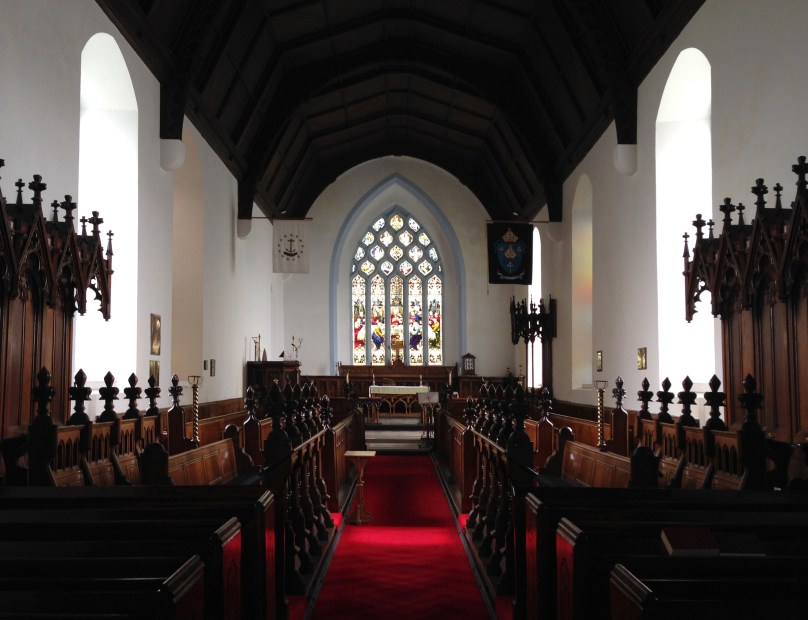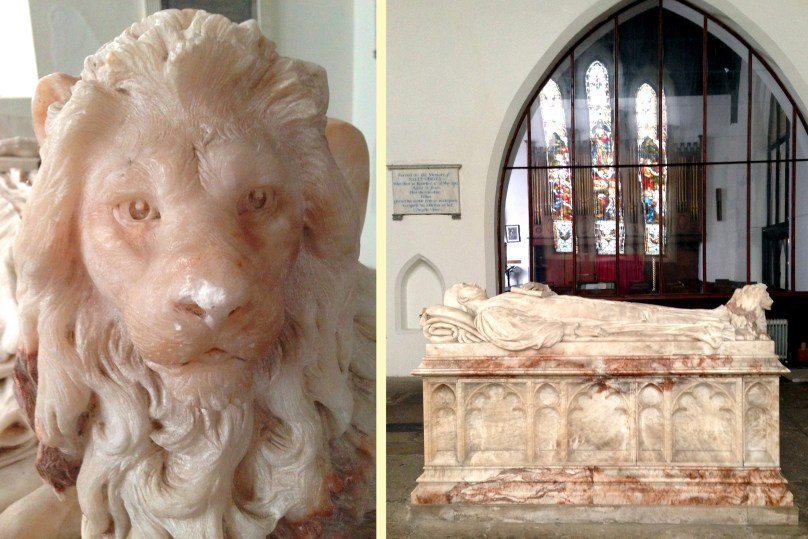In honour of the upcoming St Valentine’s Day, and of course because it’s now officially spring, my thoughts have turned to love. As we travel, here in West Cork, and in Ireland generally, we have a habit of dropping into churches. I’ve been struck by the eloquence – the purple prose – of memorial inscriptions in many Church of Ireland (Protestant) churches, dating from the 18th and 19th Centuries. Why only in those churches? There weren’t many Catholic churches in Ireland until after the Catholic Emancipation Act of 1829. In the wave of Catholic church building that followed that Act there are few examples of individual memorial tablets on the walls: instead, the walls are filled with Catholic iconography, such as the Stations of the Cross and statues of saints.
Although most memorial tablets commemorate men (particularly ministers, soldiers and noblemen) here and there you can find memorials to couples, or to beloved women, erected by their ‘disconsolate husbands’ or by a grateful parish. The first two below are from the ruined Muckross Abbey in Killarney. Here we found a stone erected by Stephen Coppinger of Cork, recounting the many virtues of his cherished Helen. The Coppingers were a Catholic family, one of whose members was the infamous Walter Coppinger of Coppinger’s Court. Another, Elizabeth Coppinger of Barryscourt, in 1760 in defiance of the Penal Laws joined with Nano Nagle and five other Cork ladies in founding a Convent of the Ursuline order in Cork.
Erected by Stephen Coppinger of the City of Cork in Memory of his late Wife HELEN Whose Accomplishments and Goodness of Disposition were her lowest Recommendations. Her solid Understanding, her diffusive, tho. judicious Charity, and strict Adherence to every Principle of the Christian Religion, the Duties of which she never ceased to perform, her Patience and Resignation during a lingering and tedious course of Sufferings, rendered her an Object of Admiration to all who had the Happiness of knowing her. She lived beloved and died lamented the 9th of August 1802. Aged 49 Years.
Also in Muckross Abbey we found this stone to Lucy Gallwey – so generally esteemed that the inhabitants of Killarney erected the memorial. A little sleuthing on my part discovered that Lucy was born Lucinda Grehan in Dublin, and that she and Christopher Gallwey had nine children.
Lucy
Wife of Christopher Gallwey of Killarney, Esq. This monument was erected By the inhabitants of Killarney and its neighbourhood to testify The deep sense of those amongst whom she lived And the Exemplary fidelity With which she discharged the relative duties of wife mother and friend as well as to perpetuate the recollections of the many benefits she conferred upon society and to hold up to the emulations of posterity her active useful yet unostentatious exercise of the most ardent charity directed by a singularly sound and well regulated understanding. She died the 14th of December 1829 aged 57
In St Patrick’s Cathedral in Dublin we came across this lovely plaque for Elizabeth, Viscountess Doneraile. (In the same Cathedral is an enormous memorial to the Boyle family built by Elizabeth’s great-grandfather Richard Boyle, Great Earl of Cork – but that’s a whole story in itself.) I love the wording of this one – not just that he loved her, but sincerely respected her.
ELIZABETH, VISCOUNTESS DONERAILE
Wife of the Right Hon Hayes Sentleger, Lord Viscount Doneraile, Daughter of the Right Hon Joseph Dean, Lord chief Baron of the Court of Exchequer in 1715, and of Margaret Boyle, Daughter of the Hon. Roger Boyle, of Castlemartyr, in the County of Cork, Esq. She departed this life on the 3rd day of Dec, 1761, in the 59th Year of her age. She lived universally esteemed & died universally lamented. Her disconsolate husband, with whom she lived in perfect harmony forty Years, hath caused this Monument to be erected in testimony of the Love which he bare her, and as a memorial of his sincere respect for her many great & amiable Virtues.
Here’s one from Cloyne. And what a lovely thought – to have years of uninterrupted conjugal affection and then to “gently fall asleep.”
The final one is also from St. Patrick’s Cathedral in Dublin and it’s for Stella, whose real name was Esther Johnson, lifelong friend and companion of Dean Swift. At his request, he was buried alongside her.
Dear Reader, do you have a favourite memorial tablet erected by a disconsolate husband, or extolling conjugal affection? If you do, post them to our Facebook page – we’d love to see more of these.
I’m now busy composing a suitable epitaph for myself…let me see, er, amiable accomplishments Well regulated mind joined with admirable charity. The kindness of her disposition was matched only by the elevation of her thoughts. Natural perfections. Guess I’ll keep working on it. The emulations of posterity can wait a while.



















